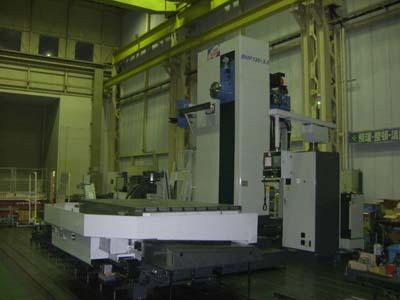
The new Nissin HBM BHP130-3.5 Series Horizontal Boring and Milling Machine from SNK America Inc. is rigidly designed for accurate and tough, prolonged cutting.
The heavy cast iron construction of the HBM BHP130-3.5 is complemented by the scale feedback of the worm and wheel. Large worktables, featuring nine T-slots, simplify work fixturing. The HBM BHP130-3.5's extra-wide solid boxways, precision finished using SNK's "Mirror Surface Finish" technology, easily accommodate the largest parts. Oversized ballscrews on all linear axes provide consistent precise positioning in the most demanding machining conditions. The combination of a robust design, thermal compensation and scales on axes results in high accuracy.
The HBM 130 Series' high-powered boring spindle (5.1" diameter) performs at speeds from 5 to 3,500 rpm and travels within a 7.08" milling spindle to provide a full 90.5" stroke. A built-in rotary table provides a fifth axis of operation, and positioning control within 0.001 degree.
Further enhancing precision, Thermal Growth Sensors are positioned around the spindle casting and bearing. These sensors continually read temperatures (withinµm) in five areas — more than most competitor machines. The additional sensors reduce the risk of false readings, and ensure accurate compensation.
The table size of the BHP -3.5 model is 70.8" x 98.4" with a maximum load capacity of 44,000 lbs. Strokes are 138" (X-axis), 98" (Y-axis), 63" (Z-axis) and 27.5" (W-axis). X, Y, Z and B-axis scale feedback is included as standard. The 60-tool ATC features a pneumatic pedal for ease in loading and unloading tools. All SNK Nissin HBM machines are equipped with Fanuc 16iM CNC controls.
Contact Details
Related Glossary Terms
- boring
boring
Enlarging a hole that already has been drilled or cored. Generally, it is an operation of truing the previously drilled hole with a single-point, lathe-type tool. Boring is essentially internal turning, in that usually a single-point cutting tool forms the internal shape. Some tools are available with two cutting edges to balance cutting forces.
- computer numerical control ( CNC)
computer numerical control ( CNC)
Microprocessor-based controller dedicated to a machine tool that permits the creation or modification of parts. Programmed numerical control activates the machine’s servos and spindle drives and controls the various machining operations. See DNC, direct numerical control; NC, numerical control.
- gang cutting ( milling)
gang cutting ( milling)
Machining with several cutters mounted on a single arbor, generally for simultaneous cutting.
- milling
milling
Machining operation in which metal or other material is removed by applying power to a rotating cutter. In vertical milling, the cutting tool is mounted vertically on the spindle. In horizontal milling, the cutting tool is mounted horizontally, either directly on the spindle or on an arbor. Horizontal milling is further broken down into conventional milling, where the cutter rotates opposite the direction of feed, or “up” into the workpiece; and climb milling, where the cutter rotates in the direction of feed, or “down” into the workpiece. Milling operations include plane or surface milling, endmilling, facemilling, angle milling, form milling and profiling.
- milling machine ( mill)
milling machine ( mill)
Runs endmills and arbor-mounted milling cutters. Features include a head with a spindle that drives the cutters; a column, knee and table that provide motion in the three Cartesian axes; and a base that supports the components and houses the cutting-fluid pump and reservoir. The work is mounted on the table and fed into the rotating cutter or endmill to accomplish the milling steps; vertical milling machines also feed endmills into the work by means of a spindle-mounted quill. Models range from small manual machines to big bed-type and duplex mills. All take one of three basic forms: vertical, horizontal or convertible horizontal/vertical. Vertical machines may be knee-type (the table is mounted on a knee that can be elevated) or bed-type (the table is securely supported and only moves horizontally). In general, horizontal machines are bigger and more powerful, while vertical machines are lighter but more versatile and easier to set up and operate.
